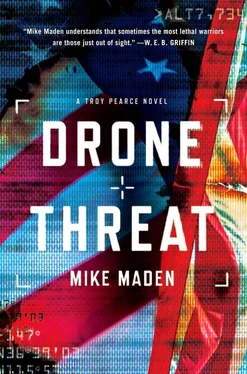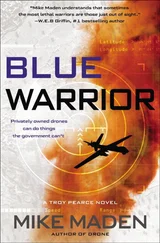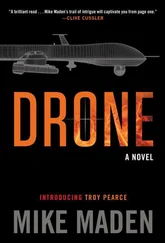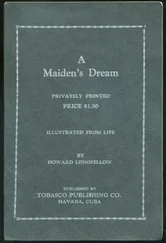Failure at Black Dart was not only expected but encouraged. The anti-drone technologies still lagged behind the galloping progress of military and civilian drone advances. If participants believed that failure might lead to a loss of a potentially lucrative DoD contract, they might not bring their latest and greatest “bleeding-edge” systems to the anti-drone game. Pentagon simulations at the event provided participants with real-world and real-time scenarios — the perfect venue to test and improve new designs. Black Dart had seen successes from mundane approaches like snipers in helicopters to more extreme ones like suicide drones. But the most exotic solution, and the most promising, was the laser.
After graduating from the University of Tennessee with a BS in physics, Ponder went on to earn a PhD from MIT. He later worked briefly for MIT’s prestigious Plasma Science and Fusion Center before striking out on his own and starting his own company, specializing in antimissile laser technology. He invested heavily but lost out on a bid for developing the U.S. Navy’s Laser Weapons System (LaWS), which was first deployed in the Persian Gulf in 2014 on board the USS Ponce . Laser shots to knock out missiles and aircraft cost less than sixty cents each, and the laser “ammo” supply was infinite so long as the ship’s power plant was intact. Standard antiaircraft missiles cost tens of thousands of dollars each, were finite, and, like other kinetic systems, had to be manufactured, transported, resupplied, and reloaded.
Starting from scratch, Ponder set out to construct a viable anti-drone laser system. The one Pearce saw demonstrated at Black Dart impressed him, but it was too large and expensive. Two years ago he put up venture capital for Ponder’s new company, Goose Gap Photonics, in exchange for first right of refusal for a smaller, portable version of his modular laser system. Ponder wanted to sell his entire operation to Pearce Systems. His health was failing and he wanted to leave a sizable inheritance to his seven grandchildren.
Ponder pointed at the old flatbed. “I call her the War Wagon. You know, after the John Wayne movie.”
“That’s it?” Pearce asked as he climbed onto the truck bed. There were four separate modules, each self-contained but linked to each other with a single connector. All four modules could be packed up in hard plastic shipping cases for transport, each light enough to be carried by one or two people. Three of the modules were long, rectangular shapes. The third was a mounted tripod with a gimbaled head, its legs fixed to the truck bed.
“The War Wagon ain’t much to look at now. I designed everything so that you can shove all of this gear into a Humvee and mount the beam director on the roof like a machine-gun station. Completely self-contained. Only thing is, I don’t have an extra Humvee lying around to fix up or I’d have shown it to you.”
“I can get you a surplus Humvee if you want one. No charge.”
Ponder nodded. “I’d appreciate that.”
“System weight?”
“Six hundred and fifty pounds, total.” Ponder pointed a large, bony index finger at each module. “That’s the power source, a battery — rechargeable, of course. Next to it is the water-cooled chiller. And that one there is the actual fiber laser.”
“The fiber is infused with rare-earth elements, right?”
“Right. It’s the latest and greatest. A lot of advantages over the solid-state units.”
“Is that going to be a problem?” Pearce had boned up on REEs after his adventure in the Sahara. China still controlled nearly 90 percent of all rare-earth element exports, and 100 percent of those used in high-tech military manufacture.
“You mean the Chi-coms? I don’t think so. This is a standard industrial single-beam unit. Completely off-the-shelf. Plenty of them around and more where they came from.”
“How powerful is the laser?” Pearce read that the laser on board the USS Ponce was 30 kilowatt. It was meant for anti-drone, antimissile, antiaircraft, and even small antiship deployment. It would eventually replace the navy’s 20mm chain-gun Phalanx cannon system.
“Ten kilowatt.”
“What does that mean?” Pearce knew that General Atomics — the company that invented the iconic Predator drone — was trying to mount a 150-kilowatt laser on board the jet-powered Predator C (Avenger). Pearce thought the rigged Avenger looked like something out of a sci-fi flick. It was yet another technological answer to the enduring question: How can America find security in this highly insecure world? Pearce built a company on cutting-edge drone technologies, but he also knew that every war his country had lost had been to technologically inferior opponents.
“Have you ever heard of a cement drone?”
Pearce chuckled. “Not likely.”
“Good, because even if you did, I got it covered. They use five-kilowatt lasers to drill through cement, and we’re double that.” Ponder patted the laser module with his large, spotted hand. “We can punch through sheet aluminum, carbon fiber, you name it, with this little wonder.”
“Range?”
“Twenty-two miles. Units like this have been used to knock down mortar rounds and missiles. A drone won’t be a problem.”
“We’ll see, won’t we?” Pearce pointed at the tripod. On top of the tripod was a device that looked like a projector with a huge glass eye. “Is that the beam director?”
“My own design. The lightest unit of its kind. You can make all of your money back just selling those to the Pentagon.”
“Are we ready to rumble?”
“Been ready. Been waiting for you.” Ponder’s stern farmer’s face almost broke into a smile.
“One sec,” Pearce said. He leaped down off the flatbed. He pulled a four-inch magnetic square out of a jeans pocket and slammed it against the driver’s-side door with a thud. It was a red bull’s-eye target.
Ponder harrumphed. “What’s that for?”
“You’ll see.”
The lanky physicist flicked a switch and the laser unit engaged. The beam director shuttered briefly as it aligned itself. He climbed down uneasily from the flatbed, refusing Pearce’s offer of help with a dismissive grunt. The two of them took up position by the back bumper. Ponder flipped open a laptop. The laser’s gun-sight reticle was centered in the middle of the monitor.
“Let ’er rip,” Pearce said.
“Your gal there will need some help with the launch.”
“Right.” Pearce jogged over and picked up the Styrofoam airplane. Despite its massive wingspan and overall size, it was surprisingly light.
Ponder raised his fingers to his mouth and let out a shrieking sheep whistle.
Stella frowned, holding up the transmitter. “This is really old-school. We should’ve linked one of our tablets.”
“Next time,” Pearce said. “Did you bring our little friends?”
“Of course.”
“Did he see you?”
“I used to shoplift, remember?”
“And your army career began the day after you got caught.”
She laughed. “No worries.”
Pearce grasped the fuselage in one hand and held the aircraft back behind his head, as if he were throwing a javelin. “Ready to launch.”
“Aim for the far end of the valley!” Ponder shouted. “Nice and straight!” Low hills on either side of them stood a quarter mile apart, and shouldered for more than half a mile due north. Plenty of room for Ponder to land his ancient Piper Cub on the grassy airstrip.
“Fire in the hole!” Stella flipped the throttle switch. The airplane’s powerful electric motor fired up.
Pearce ran a few feet and tossed the gangly plane into the air toward the far end of the valley. The plane wobbled as it came out of his grip but quickly righted itself.
Читать дальше












